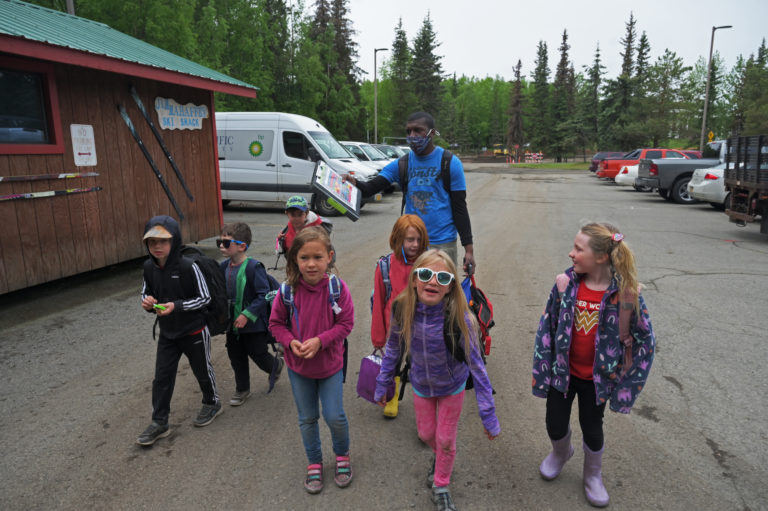
An expanded federal tax credit for working families rolled out last week as part of the American Rescue Plan Act. Many have already seen their bank accounts credited $250 to $300 per child this month. It’s a plan that experts say will cut child poverty in half across the country — including in Alaska.
Stephanie George is a single parent to two boys living in Eagle River. Her son Parker is in fifth grade and Brayden is in middle school. Both have autism. The last few years have been rough for the family.
A fire destroyed the inside of her house just before the 2018 earthquake, which meant living in hotels, rentals, and for seven months, a camper in their driveway. Taking care of both boys and their schooling without behavioral health staff during the pandemic was another challenge.
“They just require so much,” George said. “During the pandemic I had to basically do all of fifth grade with my fifth grader and stay on top of all this stuff with the middle schooler and basically reteach the fifth grader because he couldn’t wrap his brain around the distance stuff.”

George, who has master’s degrees in special education and educational administration, used to do private consulting for school districts until the pandemic hit. But she said it’s been difficult to find work that feels safe, especially because she has a medical condition that’s prevented her from getting vaccinated, and her younger son is too young to receive the shot. For now she’s relying on social security payments, food stamps and pandemic mortgage protections to make ends meet.
With all that hanging over her, George said the extra $250 a month for each of her kids won’t solve everything, but it is going to be a big help to be able to pay her bills.
“Getting that money would at least allow the basics to be paid so I can try to find something part-time or, you know, just find a solution,” she said. “Give me a little bit of wiggle room.”
In the past, families have received a $2,000 tax credit for children aged 0-16 when they filed their yearly taxes. The expansion increases the amount families qualify for and raises the age limit for children to 17. Families will receive up to $3600, or $300 a month, for every child under 6, and up to $3000, or $250 a month, for each child 6-17.
For the next six months, families can receive the first half of their money as monthly payments. The second half will be paid out when they file their taxes.
The full expanded credit is available for single parents who file as head of household making less than $112,500 or married couples filing jointly making less than $150,000. The amount decreases for families with higher incomes.
Automatic monthly payments started going out July 15, and George didn’t have to wait long for hers.
“Actually my informed delivery for USPS just came in,” she said, checking her email. “And that looks like an IRS type check in the mail today.”
Data from the Center on Budget and Policy Priorities show that 167,000 Alaskan children will benefit from the tax credit expansion. More than 20,000 of them will be lifted above or near the poverty line as a result.
Mouhcine Guettabi, an economist at the University of Alaska Anchorage, said it’s especially important for rural communities without strong economies even though the cost of living is higher in those places.
“Things are clearly more expensive the farther away you move from central Alaska,” he said. “However, those dollars potentially are more needed in those places and can potentially make more of a dent in an environment where cash is really hard to come by.”
Guettabi said he expects many families, like George’s, will benefit from being able to cover bills with the expanded credit. Others may use it to make one-time purchases to significantly improve their lives.
“There is very good research that shows that even a one time increase in income at an early stage in somebody’s life can affect their trajectory. Think about being able to put a down payment on a car so you can take your child to childcare, or get a better job. There are all sorts of little examples that could potentially alter the trajectory of somebody’s life.”
Cara Durr, spokesperson for Food Bank of Alaska, points to data projections that show less food insecurity among children in many parts of Alaska this year than in 2019. She chalks that up to relief programs like the stimulus payments and pandemic EBT benefits. She said she hopes the expanded child tax credit will have a similar effect.
“I just can’t overemphasize the importance of these kinds of resources,” she said. “And I think something like the child tax credit is really nice because it allows families to take that money and put it toward whatever their greatest need is, it’s not prescriptive.”
The expanded credit is only scheduled to last one year unless Congress takes action. George said it feels like a part of the social safety net that has been missing.
“I feel like if we’re not going to get more accessible or affordable childcare, or we’re not going to put paid leave in for parents when kids are sick, and all these different things like most first world countries have, then I really do think it should continue,” she said.
Most working families who filed taxes in 2019 or 2020 are automatically signed up for the expanded tax credit. Families who do not file taxes can go to childtaxcredit.gov to fill out an IRS non-filer form to receive their payments.



